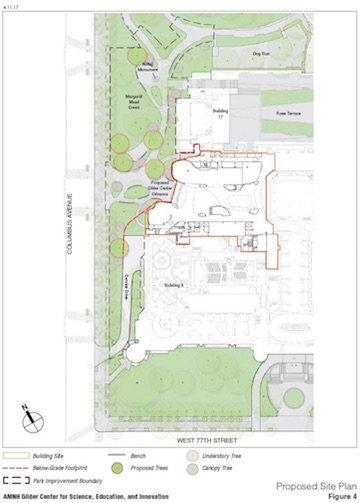
BY JACKSON CHEN | The American Museum of Natural History and the Department of Parks and Recreation has released the final scope of work for its controversial expansion, the construction of the Richard Gilder Center for Science, Education, and Innovation.
The final scope of work, made public on April 25, details all the environmental issues that the parks department, the lead city agency on the project, will look into, including open space, traffic, construction, and other matters. The $340 million Gilder Center project would create a significant museum expansion to improve visitor flow, offer more exhibition and educational space, and create a new entrance on the Columbus Avenue side of the institution near West 79th Street.
According to the final scope of work, the project would reach 105 feet tall in five stories — rooftop bulkheads bringing it up to 115 feet —add 203,000 square feet of new space, and reconfigure 42,000 square feet of existing museum space.
The expansion has attracted a considerable amount of opposition in the form of thousands of petition signatures because of its encroachment into the surrounding Theodore Roosevelt Park. The project would alter approximately 75,000 square feet of the park, according to the document.
The final scope of work offered several alternatives that would be looked into as possibilities for avoiding or reducing significant adverse environmental impacts of various kinds. The six alternatives in the document, ranging from simple to complex, include:
- Reusing administrative space for Gilder Center purposes and moving administrative functions off-site;
- Avoiding demolition of existing museum buildings by expanding the building footprint;
- Limiting the project to infill construction;
- Reducing the building footprint;
- Moving the building site to Ross Terrace, a wide area of open space on the museum campus adjacent to the Rose Center for Earth and Space; and
- Moving the proposed project to an off-site location.
Since the museum doesn’t own any off-site property, it would have to find and buy a new site for several of the alternatives, the document noted.
Cary Goodman, a vocal opponent of the Gilder Center who recently announced his candidacy for City Council District 6, said he was happy to finally see the alternatives that are listed in the document.
“This actually reflects well on the community because they really came out strongly during the scoping session last April,” Goodman said of the alternatives included. “So many people voiced alternatives and were so vehement about the museum that finally they’ve decided to, in theory, incorporate them into the scoping document.”
Goodman has repeatedly championed moving the Gilder Center expansion to a satellite location and again put his support behind that alternative. As for building on the Ross Terrace, an option that was mentioned by several people during the scoping session, he said that was his least favorite alternative.
“On the one hand, it would spare the ecological assault on Margaret Mead Green and on the Roosevelt Park trees,” Goodman said. “[But] it still involves a serious imposition on what is a very fragile and crowded environment.”
The scope document indicates that once construction begins, the museum would create a “construction coordination group” that includes representatives from the museum, the construction manager, the parks department, the 20th Precinct, Community Board 7, the Columbus Avenue Business Improvement District, and other neighborhood groups.
“The NYC Parks’s scoping process was an important step to inform the work that is going into the preparation of the draft environmental impact statement (or EIS) for the Gilder Center project,” Roberto Lebron, a museum spokesperson, said in an email.
Now that the final scope of work is complete, the next step in the process is the parks department’s issuance of a draft environmental impact statement later this spring, when the public will be allowed to comment.
































